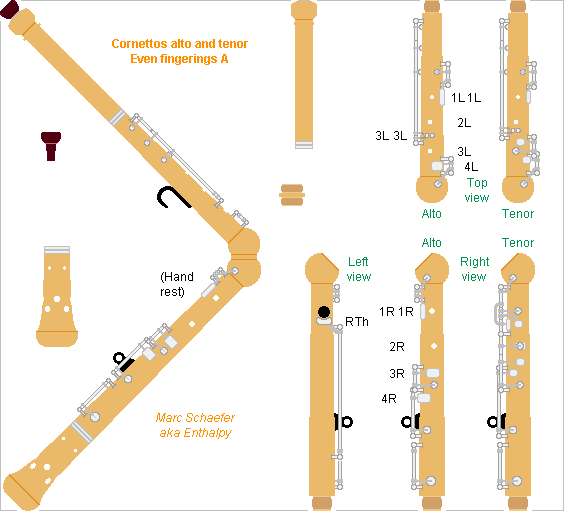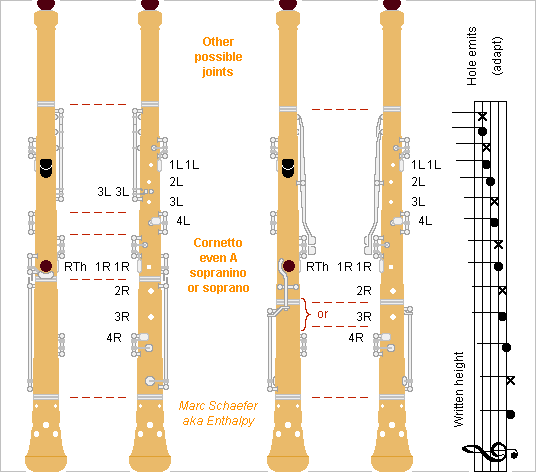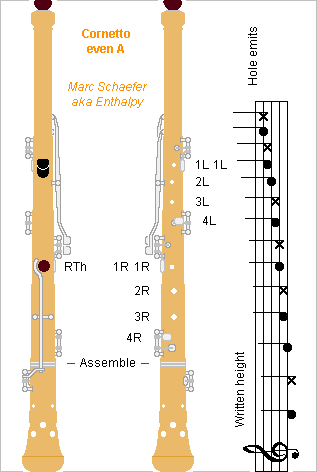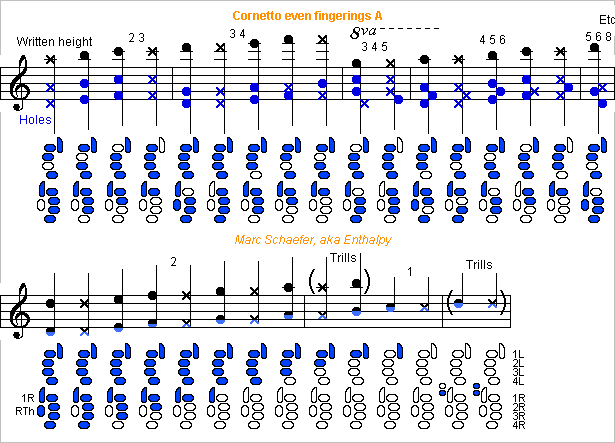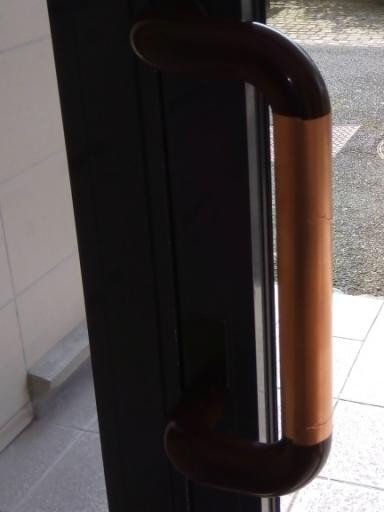-
Posts
3887 -
Joined
-
Last visited
-
Days Won
1
Content Type
Profiles
Forums
Events
Everything posted by Enthalpy
-
If a wagnertuba receives a compensator retrofit, a Bowden cable is seducing wikipedia it adapts to varied sizes and approximate positioning, for instance if the new parts are clamped on existing tubes. The same retrofit kit might equip the tenor and bass wagnertuben, with varied displacement ratios, and even be installed by the musician. A Bowden cable can also be (un-) fitted quickly on the instrument, as the Contraforte's register keys by Wolf and Eppelsheim demonstrate guntramwolf.de (picture) that would be snappy enough to evacuate water by the slide. Amplifying the displacement would be easier before the cable if possible. Marc Schaefer, aka Enthalpy
-
It would be fantastic to retrofit existing Wagnertubas with such compensators. Marc Schaefer, aka Enthalpy
-
French horn players blow the wagnertuben in symphonic orchestras and often complaint about intonation. The flare isn't supposedly to blame, or it can improve, since narrower French horns and wider tubas are built with excellent intonation. The lack of compensation must contribute much. Valves add a portion of tube length when desired, and these extra lengths cumulate, while intonation would require to multiply the tube length. If 1, 2 and 3 semitone lengths were tuned for themselves, 1+2+3 semitones would be a semitone short. Widening the 1, 2 and 3 semitones makes a bad compromise. Solutions are known. Trumpet players move an extra slide to compensate manually the piston combinations. Saxhorns have often a fourth valve or more to replace the 2+3 semitones combination. More complicated valves and tubing can make a compensating system. And at French horns, the musician moves the right hand in the bell to change the height. All this is difficult at Wagnertuben. Even if made accessible, the bell must be too wide for a hand. Horn players don't use the other systems normally, which cost money and take time to train, possibly too much to serve every second year. Pictures of Wagnertuben, with a fourth valve: gebr-alexander.de I propose to add to wagnertuben a compensation slide moved by the full right hand, not by a finger of the (here left) valve hand. By the palm, or by four fingers, or both, in a movement that imitates the hand action in the bell of a French horn. Some transmission shall also imitate the pitch sensitivity of the French horn. This is cheap, and hopefully, horn players can use it immediately. I've seen musicians put their right hand at the lead pipe, possibly to apply the mouthpiece on the lips. The wide trigger could then sit there. The pictured wagnertuben have just after the valves a slide that may serve as a compensator. Or add one at the lead pipe or elsewhere. It needs about a semitone lengthening. Marc Schaefer, aka Enthalpy
-
Last time I tried a tenor flute (often called bass) and lower ones, I couldn't achieve anything decent despite being easier on the alto than most other flautists. But here are "contrabass and subcontrabass" flutes that work obviously: the horn player achieves a sound, the flautist plays a score with long notes. Ns7NwOjG5wg at t=572s If the microphone setting was kept between voice and flute, the instrument would even be perceptible. Do you see the long blow hole overflown for longer by the fast blown air? The instruments I tried lacked it. Fine, I don't need to explain the idea any more, but I can forget the patents. The alto flute should have a longer blow hole too.
-

Misuse? of statistics (was Navigation Ability)
Enthalpy replied to Enthalpy's topic in Other Sciences
Statistics strike again... The human ACE-1 enzyme is somehow linked with the evolution of Covid-19 and it has a known polymorphism, the D-allele. Researchers took data from 25 European countries and compared the cases of Covid-19 per million habitants in the country wih the frequency of the D-allele. The raw graph is reproduced there ncbi.nlm.nih.gov (supposedly copyrighted) If I had obtained such a graph, I'd have said "no relationship" and switched to other thoughts. Admire the random variation by nearly 100 at identical allele frequency while the best fit tries to justify a variation by 10. But the authors computed correlations (Spearman r=-0.510, p=0.01) to claim that the D-allele is a "co-factor". Papers of that kind give me mixed feelings about peer-review and research journals. ========== This is a typical case where an obscure statistical method helps get published. What could be done differently here? For instance, choose 100 polymorphisms whose frequency is known in this set of countries. Randomly, not even with a known relationship with Covid-19. Check how many among these 100 give a correlation as good (Spearman r=-0.510, p=0.01 if you like) as ACE-1. Not bad neither: keep both data sets, but swap randomly the D-allele frequencies of the countries. Some swaps will give a far better correlation than the real data. But how many swaps are better, how many are worse? As well, after an apparent correlation is found on one set of countries, check on a second set of countries if it holds. If possible, a second set not known to the researchers. I also wish, and this isn't even statistics, that the cases of Covid-19 per million inhabitants were measured at a uniform delay after the first 100 cases were observed. Before and after the increase settles, if possible. This would reduce a big noise source. ========== As we're seeking correlations, let's have a look at the distribution of Covid cases on the map of Germany, there n-tv.de seek "Inzidenz nach Kreisen" The distribution is extremely unequal, so what correlations could we find? The mainly Catholic regions are hugely more hit than the mainly Protestant ones. That correlation works extremely better than the ACE-1 polymorphism. We must urgently replace hosts with regular bread, and ban holy water, as these certainly spread the virus. Alas, double-checking on Catholic Belgium versus Protestant Netherlands ruins that explanation. But if aggregating the three countries, as Germany has more inhabitants, I'm confident that some statistical method would validate the religion correlation. Add Italy and Spain to the study, plus Norway and Denmark, if this helps. Next one: the hardly hit regions use dialects. The ones commonly speaking standard German are spared. This is even confirmed by Switzerland and Austria. So to combat Covid, police should not enforce the confinement, nor possibly the use of masks in the future, but the use of good German - provided that policemen themselves, err, well. No, dialects are politically too sensitive in Germany. But what about wineyards? The hardly hit region are the ones where wineyard grows. Again a perfect correlation. Don't look after Chinese markets for exotic animals: the pneumonia was obviously endemic to grapes (no more ludicruous than fish transmitting a pneumonia to humans). What, we can't forbid wine? OK then, the hard-hit German regions belonged to the Western Roman empire. Again a perfect correlation. And it holds elsewhere: Switzerland and Austria too are hit hard, Italy and Spain and France even worse, Denmark and Norway far less. So to combat Covid, we could just rename all cities and streets whose name derives from Latin. Easy! Or maybe the regions hit harder are richer, so more people could afford skiing in Tirol, and they brought the virus back. It explains the European West-East gradient too. But that one isn't fun. Why shouldn't you seek your own correlations? There must be zillions just as good. Have fun! -
Nice soprano tarogato sound by Laszlo Kiss Gy, Samples: amazon.com nice folkloric music More folkloric music by Laszlo Kiss Gy too 6r5PhhtVV80 - UiPV6u21oq4 - Ep6UVGVCnaA - Z-Edp2gPtXM Less ancient music played by the same musician: sSEUQebDWF8 - _TOwfXpls4Q - M6KHos2VdG0 - aZDvtvIGsz4 - Is0wVfZUwcE - KyxZYeKGS5A - 5y2ogzsI9js - Hc0S-cryeTI - and here together with a harp: btJAfAI7Sg0 - KNNQvy2aBqk - CD0AkzhkhFQ - 2iK2uux8Rj0
-
Here's a different construction for the alto and tenor cornettos with my even fingerings A. The aspect suggests less a brass, but at least it looks baroque, and the usual skills of woodwind luthiers suffice. The tenor is longer and sleeker than sketched. A strap carries the instrument at the right hand joint. A hook for the left thumb lets press the instrument against the lips as many brass players do, that's why the instrument is straight up to the mouthpiece. The right hand could get a bassoon-styled hand rest, but I suppose it's not necessary. The trill holes are on the side, all other tone holes are at the top on the left hand joint and at the right side on the right hand joint. ========== I proposed to double the lower trill cover to improve the lower semitone and full tone trills. On an instrument with narrow tone holes, the cornetto and more the oboe, this may not suffice completely. The two covers for the lower trill could get independent buttons: For the semitone trill, use button 1 only For the full tone trill, use button 1+2 The second button opens the cover that doubles the tone hole that is closed for the lower note of the full tone trill. This way, all notes of the semitone and the full tone lower trills can have perfect height and timbre. The last button opens the third cover for the upper full tone trill, as previously The same finger can make all these trills, by pressing the buttons 1, 1+2 or 1+2+3. The higher trill opens both doubled holes, but as they are two semitones lower, even narrow holes have a small effect that can be compensated by the diameter and position of the third trill hole since it serves only in this combination. Or, organise the buttons to use 2+3 for the upper trill. Marc Schaefer, aka Enthalpy
-
Hello you all, The World Health Organization published a recipe for a disinfecting hydroalcoholic mixture who.int (I saw it in English too) and refineries could produce it the big way. It's not exactly a gel, but the function is the same. Ethanol can be obtained without delay from water and from ethylene, abundant in refineries. Glycerine is a by-product of palm oil processing, especially to make biodiesel. Some refineries or companies do both. I understand pasteurization can replace hydrogen peroxide. If not, produce it. Water is available in many countries. Equipment existing at refineries must be too dirty, so new one must be added on the fly. It needs no new engineering, and specialized companies can produce it quickly. Governments must address the risk of transformation into drinks with unusual flexibility and reactivity. Marc Schaefer, aka Enthalpy
-
Here's a possible shape for an alto cornetto with my even fingerings A, as inspired by the octavin. The trill keys are at the side, all other tone holes are on the top except for the thumb key at the bottom, but it's beyond the U-turn. The U-turn needs an easy water key. A U-turn of tube, as on Heckel-style bassoons, is acoustically best. Old French bassoon achieve the function without metal shaping. Maybe longer tone holes improve the dynamic range of low instruments. Wood available between both bores at the boot would permit that. Biassed tone holes could even spare many keys. The air column's profile must compensate the added volume, as on polyconical clarinets. Marc Schaefer, aka Enthalpy
-
Here are other locations where to assemble the cornetto sopranino and soprano with even system A. The indicated note heights must be adapted to historical music and instruments. If the cornetto needs no register hole, the upper part disassembles easily, above the trill holes. The trill buttons can be at 3L instead. They seem as convenient as at 1R, are visually less imposant, and fit the alto and tenor cornetto better. Then, joints can disassemble just above or under 4L, with key shapes differing slightly from the sketch. Optionally as displayed left, the trill key emitting D opens also a secondary C# for nicer C/D trill. Instead of below 4R, the cornetto can disassemble below 3R or 2R with adapted key lengths as displayed right. Displayed left, adapted key shapes let disassemble below 1R. Separating only the bell, below any key, can save raw material. Marc Schaefer, aka Enthalpy
-
An existing cornetto fingering chart: gtmusicalinstruments.com also as pdf download The range exceeds two octaves, excellent for a sopranino with recorder-like fingerings. The instrument octaviates imperfectly, as expected from recorder-like fingerings. Since tweaked fingerings shall correct the intonation, it can't be perfect, and supposedly the musicians lips the height further. This gives me hope that my improved keyworks, together with a bore optimized by experiments plus the tutt software or equivalent la.trompette.free.fr can not only make an easier instrument with good intonation, but also achieve a big range, especially at tenor and bass variants. And of course, keep the nice original sound.
-
Longer record, only music, four Wagnertuben and four horns, again Bruckner 7's adagio ilOPL88WsNw nice to hear the difference of sound.
-
I wore the coffee filter hold with double-sided tape for carpets because my usual surgical tape doesn't stick any more, and it held.
-
gtmusicalinstruments has a better page to listen the cornetto, there gtmusicalinstruments with more music on this instrument.
-

COVID-19 antivirals and vaccines (Megathread)
Enthalpy replied to Alex_Krycek's topic in Microbiology and Immunology
Strange, don't lie to favour your misconceptions.- 163 replies
-
-3
-
I had suggested it on January 27, 2019 07:39 PM and followings scienceforums and the ancient Chinese Konghou harp has already soundboards parallel to the strings. How loud is the Konghou? It seems to work very well. Hear the exquisite sound XqT7nfXTp5c I like immediately this music from the opposite side of Earth. Because a harp carries it? The low notes sound deep, better than the Erard-style harp Pc2mD5vAhww - E1aUfdLSi64 - 04oWysYCN0o - Gv0DOFkhFm4 - UbYA_K9QoWc that's what I expected from the bigger and more flexible soundboard. Introduction: the instrument abandoned for centuries was revived and modernized around 1980 QReFNf4RzAM 7 notes * 5 octaves, right and left identical. Double-movement pedals identical to the Erard design. Erard-system harpists can play the Konghou immediately 1oO_oCAlWxM - ZuUrtGTfWoM so European and US luthiers should make harps with vertical soundboard before all musicians prefer the Konghou. Equalling the range of the concert harp is a matter of resistance and stiffness, and the tall Konghou soundbox helps, while the neck can be taller at the centre. Steel gains a bit over wood. I had proposed a single-strung instrument instead. Stress halved, and the harpist sees better, but the soundboard is shallower at high notes. The Konghou's bridges stress the soundboard far less than the Erard-style does. My proposal to imitate the piano or to pull at the board's end injects no side force at all. This enables a lighter and louder soundboard.
-

COVID-19 antivirals and vaccines (Megathread)
Enthalpy replied to Alex_Krycek's topic in Microbiology and Immunology
Experts are seldom thrilled by suggestions made by outsiders, but outsiders bring most progress. Yes, ideas are badly scarce,. And on the Internet, you find the same people as in companies, with the same skills but not as grossly misused. Think at the Steinway. The production of fullerenes or graphene. The chipcard. The contactless chipcard. Many solutions for the Fukushima disaster. Paypal. SpaceX. Tesla. And so on and so forth. Waiting for experts, or worse for known experts, to solve everything and bring all innovation is a recipe for stagnation. It's also contrary to observation. -

COVID-19 antivirals and vaccines (Megathread)
Enthalpy replied to Alex_Krycek's topic in Microbiology and Immunology
One step better, IF silver destroys the Covid virus efficiently: Deposit a silver film directly on the handle or the item. Solutions exist for that. The surface acts as a catalyst, and it doesn't have to be metallic. Easier than copper, mechanically safer. Primers or treatments may be useful, or not, to let the silver layer adhere on varied materials. Handles are often coated with some unreactive polymer. Degreasing is a minimum, maybe sanding a little bit with quite fine paper. Silver handles could be useful in hospitals for instance. Marc Schaefer, aka Enthalpy -
Brass instruments with side holes are played quite rarely: cornetto = zink = cornett, serpent, ophicleide scienceforums - scienceforums Their mellow sound seems strong and has no equivalent among modern instruments. Excepted for the ophicleide, their fingerings and (lack of) keyworks are said to resemble a recorder, which hampers good tuning. Recorder fingerings also use to make timbre and ease of playing uneven, but this isn't patent on the records. So shall they get my even fingerings? They bring holes all open below the main transition, with regular spacing and diameters. Here my oboe even fingerings D scienceforums - scienceforums are slightly adapted, becoming the cornetto even fingerings A, where many bare holes give an antique look. Here I suppose that the lowest note can octaviate properly, then one thumb key suffices, with two throat trill keys like the clarinet has. These fingerings are mere indications that the scheme is flexible enough to enable high modes evenly. The fingerings will evolve if the instrument is built and tried. For instance if the tone holes are a semitone higher than the pressure node, this holds for the main transition, but isolated holes tend to sit at the pressure node. All fingerings can drift upwards or downwards, though compatibility with my oboe system would be nice. I've drawn no register keys, do they help a labrophone? I'd keep the cornetto's bore width, important for the sound and range. Sideholes about as narrow are all-important too. If the lowest side holes are narrow for good sound, then the instrument should have Stowasser's small holes before the bell, as depicted above. Chambers at the tone holes can remove the strident component of the grain if needed, split holes remain efficient at low instruments scienceforums - scienceforums ========== Regular hole spacing is expected to ease high registers by using isolated open holes, and low brass are known for their huge range. So should the cornetto family get my automatic fingerings? scienceforums - scienceforums and next They play a big range much more easily but lose the simple keys and antique look. ========== The cornetto made a family with varied sizes, the serpent being a bass. When modernizing, it's tempting to create two instruments per octave, shaped like the sarrusophones for instance, rather in C and F. Though, the ability to play old scores is very important. I would not keep the serpent's hole positions. Regular spacing is important, keys enable that. Hole diameters shall bring a consistent timbre in the family, not imitate the serpent. ========== Old instruments were probably of BuxusSempervirens, still excellent for small parts and looking antique. Dalbergia melanoxylon outperforms it but is endangered. Liquid crystal polymer would outperform both with graphite choppers, or maybe pure if stretched during injection or extrusion. Marc Schaefer, aka Enthalpy
-
I suggested liquid crystal polymer (LCP) for wind instrumens body and more parts. Graphite choppers increase E=11GPa to E=23GPa, exceeding Dalbergia melanoxylon. But cutting tools may wear out faster. LCP is known to stiffen quickly and strongly along the injection direction. Often undesired in injected parts, this effect gives LCP fibres E=270GPa, and would improve a body made from extruded or injected raw material. Instruments accept a transverse stiffness somewhat lower, so adjustment room is available. Stretched LCP could then be stiffer and denser than Dalbergia melanoxylon but spare the cutting tools. Marc Schaefer, aka Enthalpy
-

COVID-19 antivirals and vaccines (Megathread)
Enthalpy replied to Alex_Krycek's topic in Microbiology and Immunology
The friend sent me pictures of copper tape on the doorhandle: The sheet's edges are a weak point of the construction. They might hurt the user or accumulate dirt and viruses at the concave angles, spoiling the benefits of copper. That reason favours the broad copper tape over my proposed helical winding of narrow tape. Rounded corners would stay glued on the handle and be less dangerous. Maybe solder would secure the edges and fill the concave angles. I'd also flatten the edges by pressing with a hard round tool, maybe a light hammer, before sticking and soldering, and sand after soldering. It's not investigated against Covid, but usually silver sterilizes better than copper does. Solutions exist to deposit it on copper by immersion. -
Maybe. Or maybe not. I feel reasonable that a filter stops the droplets in both directions, and even small ones. But this wasn't my point there. Point was that the French quartet tells "filters are efficient for everyone" and "in both directions", which is quite the opposite of the former gov communication. And that they tell that the gov had alleged "masks inefficient and protect only the others" because masks didn't suffice for everyone. And better, that the French quartet serves probably to prepare the public opinion to the brutal change of governmental policy, from banning masks to making them mandatory. I had wondered how the gov would do that, here we are. Next step: gov explaining to the people that Daesh is our ally again. That one will be less easy. Let's observe how they do it.
-
Wood profiles have wide standard tolerances, and I've never seen a part using the upper range of the tolerance. This is for metric units. So: manufacturers achieve a far better accuracy than what standards require, and use this capability to produce more parts from the timber.
-
Hi everyone! Both single and double sided adhesive tape can leave marks that are difficult to remove from the items. One nasty case is on scissors used to cut the tape. Small debris of the adhesive tape on the blades separate them, and the scissors can't cut. Removing these marks is lengthy. An eraser removes these marks like magic, quickly and perfectly. Marc Schaefer, aka Enthalpy
-
Fun: In France, a group of four people appeals the government to produce faces masks and make them mandatory leparisien.fr (in French) This comes as masks from China arrived in France, and French companies are ready to produce. The appeal's style is quite critical to the gov, BUT at least two authors regularly do what pleases the gov. So I understand that the gov changes its policy about face masks, and this appeal is a way to prepare the opinion. And that's only the least sly scenario. Alternately, the European governments could have decided to let the whole population contaminate itself to avoid later waves of illness as happens in Hong Kong, but they were surprised by overwhelmed hospitals. That policy would explain some hostile reactions when I wear a face mask. Some arguments are fun: The population were advised not to wear masks because there were too few. I mean, paranoiacs, conspirationists, fake news. Masks are efficient for everyone, and even in both directions. Don't wait for a certification. Sure, the industry is ready to sell.


